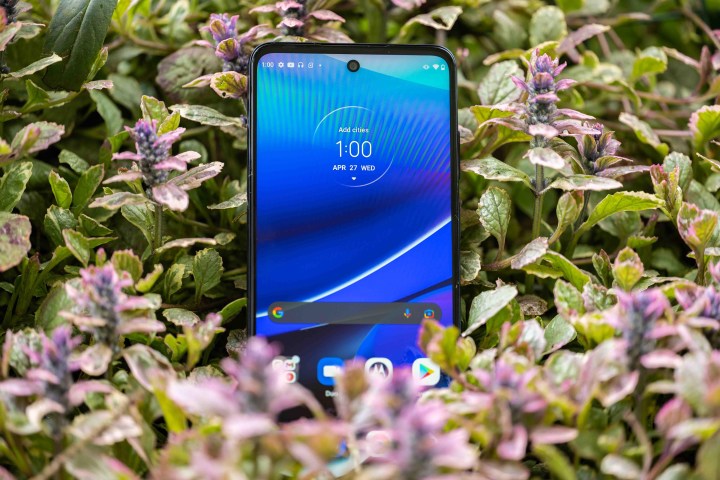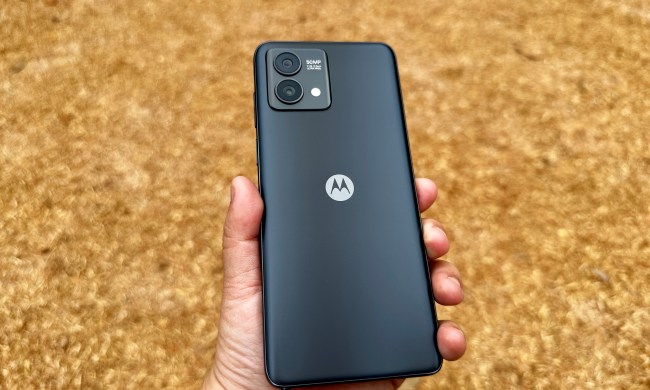My first thought upon seeing the Moto G Stylus 5G was how much it reminded me of the Motorola Edge+, which I recently reviewed. Fresh out of the box, the two are nearly identical in appearance. However, the G Stylus has some extra tricks up its sleeve, one of which is the fact that it has a built-in stylus that invites comparisons to Samsung’s S22 Ultra. The other is a very affordable price tag. The question is, can such a low-cost smartphone offer an experience that compares to such flagship devices?
Design and display: Looks great, feels cheap
As mentioned, the G Stylus looks an awful lot like the Edge+, and that’s a good thing. It’s a beautiful design that manages to negate some of the inconvenience of the camera bump. Unfortunately, the G Stylus doesn’t have that premium feel to it like the Edge+, and the backplate is a real fingerprint magnet. However, if you’re like me, a phone comes out of the box and goes immediately into a protective case, so lower quality backplate materials are a good place to reduce production costs.

The tall, 6.8-inch screen looks great, its FHD+ resolution is good enough, and colors/contrast are fine by my eye. Best of all is its 120Hz refresh rate, which allows for fluid navigation. Touchscreen functionality is responsive, and haptic feedback is similarly decent. Bezels are fairly large and noticeable, but not offensively so.
The G Stylus comes with 128GB of internal storage and features a microSD card slot, which is something of a rarity these days. There’s a fingerprint reader on the side, and the selfie camera is of the hole-punch variety.
Stylus: Shockingly good

I honestly wasn’t expecting much from a built-in stylus in a smartphone at this price point, but the Moto G Stylus surprised me. It’s reasonably accurate and very usable for jotting down quick notes, or for the operation of other functions. Pop it out while the phone is on and a little quick menu opens up with shortcuts to various stylus-centric applications. Pull it out when the phone screen is off and you can scribble out a note without having to unlock your phone.
The action of pressing the stylus in to unlock it, and of clicking it back into place is great, and it has a high quality, premium feel to it. Additionally, the Motorola notes app is excellent, as is other included software designed to work with the stylus. It makes capturing screen recordings/screenshots a breeze, and the coloring book app can be a fun distraction. I really like how you can take any photo and convert it instantly into a coloring page, though I will say the stylus isn’t quite accurate enough to be a tool for professional artists.

Naturally, this stylus invites comparisons to Samsung’s S-Pen, and of course, the S-Pen is the far superior tool. However, the Moto G’s stylus is competent enough, given the price differences between the Moto G and phones equipped with the S-Pen.
Performance and software: Inevitable compromises
Given the Moto G Stylus’s highly attractive price point, compromises have to be expected, and the compromises here make themselves most apparent in the Qualcomm Snapdragon 695 5G processor and mere 4GB of RAM. For the most part, this doesn’t make itself felt in most everyday circumstances, but I did occasionally run into slowdowns where the phone visibly struggled, such as in the camera app.
This lack of power is most noticeable when playing graphically intense games. DOTA: Underlords crashed completely if I ran it at any higher than the very minimum settings. However, at those minimum settings, it ran fine, and in general, the G Stylus is powerful enough that I’m able to appreciate its fast 120Hz display.
It includes an actual 3.5mm headphone jack, which is something of a rarity in modern smartphones.
A possible upside of the G Stylus is battery life, thanks probably to those relatively low power specs coupled with a respectable 5,000mAh battery. My impression during my brief time using the phone is that it should easily last a full day without needing to be topped up. In terms of connectivity, the G Stylus 5G is, as the name implies, compatible with
In terms of software, the G Stylus runs Android 12 with only fairly minor alterations by Motorola. It works great, and I had no complaints about its operation in this regard. I didn’t encounter any bugs or unexpected issues. On the audio side of things, speakers and microphones are perfectly acceptable, if not particularly impressive. 2Cellos cover of Thunderstruck lacked definition in the bass range, while Billy Talent’s Rusted From the Rain sounded a bit tinny. However, it makes up for this by including an actual 3.5mm headphone jack, which is something of a rarity in modern smartphones.
Camera: Great pics for the price point

Considering that this is a relatively affordable phone, it’s impressive that it carries a very comparable camera to the Edge+. While I wasn’t very impressed with this camera setup in the Edge+, given how expensive that phone is, in the Stylus G it’s much more compelling.
The front camera of the G Stylus features a 50MP camera with optical image stabilization and quad pixel technology. It sits alongside an ultra-wide-angle camera with a 118-degree field of view and macro vision capability. The third camera is actually a depth sensor. Both cameras take good photos that are sharp and colorful, though the macro vision suffers from the same stabilization issues that so annoyed me when testing the Edge+. It’s a cool feature but requires either a very steady hand or a tripod to reliably capture sharp photos.
Now we get to where the camera system of the G Stylus diverges from that of the Edge+ — most notably with its selfie camera, which offers a mere 16MP with quad pixel tech, compared to the 60MP of the one found in the Edge+. I would say the G Stylus selfie camera does OK for a phone in this price range, but it’s definitely nothing special. Another key downgrade to note in the G Stylus camera is how basic its video capabilities are. It’s limited to shooting in 1080p at up to 60 fps with the main camera and 30 fps with the ultrawide camera.
On the plus side, you do get portrait mode, a pro mode that offers more advanced photography features, panorama mode, and a handful of other useful capabilities. The bottom line is that this is a great camera system for photography given the price point, so long as capturing high resolution or super slow motion video doesn’t matter to you.
Price, availability, and comparisons
The Motorola G Stylus 5G will be available in the U.S. starting today with an MSRP of $499. Given my experience with this phone, I’d say this is something of a bargain. It comes remarkably close to the Edge+, given the wide gulf between the price point of these two phones, and adds a stylus, thus making it a reasonable, cost-saving alternative to the Samsung Galaxy S22 Ultra.

Conclusion
It would be unfair to judge the Motorola G Stylus 5G for the compromises that had to be made to reach this highly affordable price tag. It’s not going to play the latest mobile games at max settings, and it’s not great in terms of video recording capabilities, but neither of those should be a dealbreaker if you’re shopping for a phone that costs as little as the G Stylus. It’s far more useful to consider the G Stylus as a device that offers much of what you’d expect from a high-end Motorola or Samsung phone at a cost that won’t break the bank.

The Motorola G Stylus 5G is the phone I would personally recommend to a friend shopping for a modern, fully-featured phone on a tight budget.












